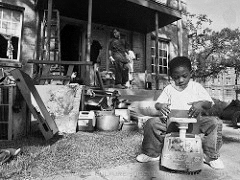
This is not a contest: Both community development and income mobility strategies have merit. But, as climate change becomes an increasingly grim reality, we need to double down on community resilience. That means new attention to—and investments in—low-income communities of color.
Doubling down on community resilience is not an affront to fair housing. Rather, it is offered as an antidote to climate crises, which present a new and real challenge to the long-standing vulnerabilities of low-income communities. It recognizes the historic significance of resilience as an essential survival mechanism, especially for communities of color. It warns against its further erosion by both public and market forces. And it offers an important measure of the success—or failure—of fair housing efforts.
Clearly, fair housing is a key building block in a social and economic justice agenda. The historic battles against restrictive covenants, exclusionary zoning and mortgage redlining are matched by contemporary struggles against “poor doors” and other non-discriminatory affordable housing and mixed-income housing schemes.
In addition to tearing down these institutional barriers, it is critical to upend the personal prejudices and discriminatory practices of landlords who deny housing opportunities on the basis of race, gender, religion, family status or other defining characteristics. This is part of the fight for American democracy.
Nothing drives this home for me more than my own personal experience. In the early 1970s, I moved to a largely all-white city in the Northwest to take advantage of an educational opportunity. Suffering the indignity and rage from being called a racial epithet and then being denied an apartment on the basis of my race was bad enough. What was worse was how alone I felt. The people around me, who did not share my lived experience, told me to “just forget it.”
After one week I left. I moved back East to live among people who shared my sensibilities, in a community I could count on when things got bad. This is my backstory to community resilience. I submit it is a story shared by many others from communities of color.
Rather than negate the pursuit of the perfect union, it exposes the reality of living both the ideals and contradictions of American democracy. For African Americans, integration vs. segregation or self-determination as the pathway to economic and social mobility is a legacy battle. It defined the central philosophical differences between W.E.B. Dubois and Booker T. Washington, as well as between Martin Luther King and Malcolm X. And, for most African-American families, this same unresolved ideological debate surfaces every Thanksgiving holiday season and at other large family gatherings.
The fact is, contrary to the commentary, community resilience is not a fad nor is it a rejection of the ideals of integration. It is a lifestyle for many low-income families and/or people of color who are living in hostile environments. In addition, and especially for African Americans, it is a badge of honor; enduring—and often thriving—despite 350 years of oppression and discrimination.
Gentrification is a threat to community resilience that can lead to social, economic and political isolation of vulnerable groups. America’s unfinished business includes the effect of dislocation and the destruction of resilient urban communities by racially motivated burnings, “urban renewal” policies, and divestment. Historically black communities including Pennsylvania Avenue in Baltimore; Saints Street in Frederick, Maryland; Beale Street Community in Memphis; Greenwood, Oklahoma; or the Central Avenue community in Los Angeles were segregated. But they offered important cultural, economic and social capital and safety nets—providing jobs, credit, housing, mutual aid, and basic services for families at all income levels in the face of harsh deprivations.
Given that the climate crisis is real, we have a new imperative and opportunity to rebuild the resilience of communities across America. How do we survive hardships of extreme weather, power outages, or food and water shortages? Resilience requires an investment in place-making to facilitate the social cohesion and material supports—housing, economic opportunities, distributed power, transportation and health services—when there is no where else to turn. These challenges are universal. So are the opportunities to transform America with renewed values of sustainability, equity, and community.
Well, I guess I’m ready for this year’s Thanksgiving dinner discourse. I can’t wait.
(Photo credit: courtesy of Culture:Subculture Photography via flickr, CC BY-NC-ND 2.0)





Comments